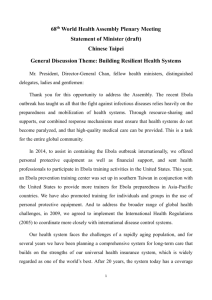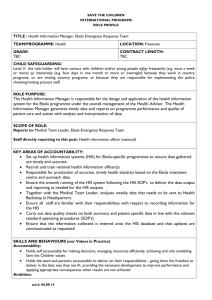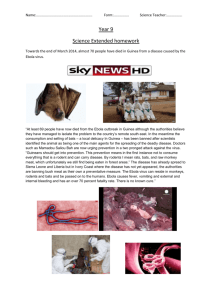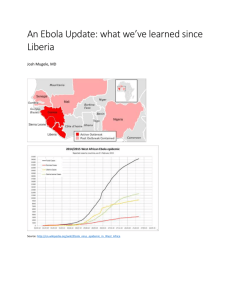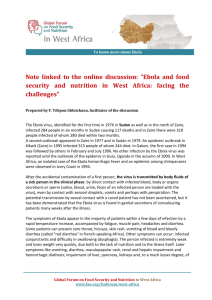GUIDE DES MESSAGES
advertisement
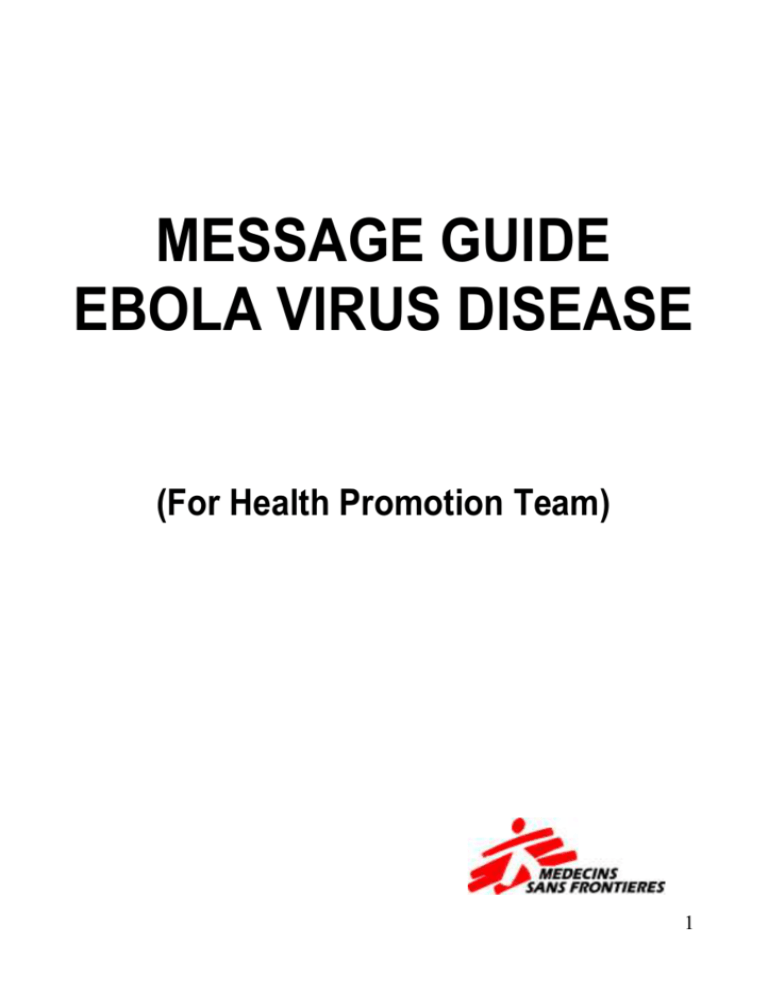
MESSAGE GUIDE EBOLA VIRUS DISEASE (For Health Promotion Team) 1 NOTE - This guide brings together the main messages that community health workers (CHWs) need to know. All activities at the health facilities should utilize the Information Education Communication (IEC) materials as tools explaining them to patients and the community. In addition this guideline may be used in outreach and supported by IEC materials. - This guide should not be read to the target population and will only serve to support health promotion teams. The messages must be adapted to the context and the target population. Especially concerning funerals and burial practices. The messages of this guide may be spread in a single session using participatory techniques. A session of Questions / Answers must be provided at the end of each session. Sessions should always be monitored and recorded in a notebook (or on a monitoring form) and number of participants (women and men) should also be recorded. Good luck ! - 2 WHAT IS THE VIRAL HEMORRHAGIC FEVER EBOLA ? Ebola hemorrhagic fever, now known as Ebola virus disease, is a serious, contagious and very deadly disease caused by a virus. Ebola is the name of a river in the DRC where the disease was discovered in 1976. There is no cure or vaccine against Ebola, but there is good medical treatment. To prevent the spread,of Ebola it is necessary first isolate the sick person and then to begin case management, thus protecting the family and community. Ebola is an exceptional disease because of its dangerous nature. We talk about it to prevent its spread and to safeguard the community. WHICH ARE THE SIGNS OF EBOLA? - Symptoms begin between 2 and 21 days after infection, Ebola is characterized by the following signs: Drawing 2 Comment! This image does not show all the common signs and symptoms of Ebola but it’s a good place to start talking about the others o o o o o o o High fever (brutal and prolonged) Abdominal pain Joint or body pain (especially the chest) Difficulty in swallowing Headache(s) Nausea, vomiting (can be bloody) Diarrhea (can be bloody) 3 o Dehydration (no tears, dry tongue, sunken eyes). o Rash o Spontaneous abortions o In some cases bleeding from the mouth, eyes, nose, ears, anus. During the incubation period, meaning before these signs appear, the infected person cannot transmit the disease to others. A person is contagious when one begin to have one or more signs of the disease. - HOW EBOLA IS TRANSMITTED? The Ebola virus is spread by: - Contact with infected bush-animals (mostly monkeys and bats). - Drawing 1 - Contact with a person infected by the Ebola virus. Direct contact with body fluids: blood, vomit, sweat, tears, saliva, urine, feces, breast milk, sperm, vaginal secretions, and runny nose. Drawings 10 to 18 - Urine and stool Vomitus Saliva Tears - 4 Blood Snot Breast milk Sweat Comment! Might be frown at in some traditional communities To be used with caution! - Sperm and vaginal secretion - A person can be infected if any of the above liquid(s) goes into his/her body by: the eyes, nose, mouth, sex, or injury on the skin. Drawings 4 to 9 In the Eyes Sex - In the Nose The Mouth Injury or small cuts on the skin Contact with droplets of body fluids, for example by coughing (saliva). Unprotected (no condom) sexual relations with an infected person. Breastfeeding (from an infected mother to her child) Physical contact with a person who died of Ebola. 5 When a person dies of Ebola, the body is highly contagious because it leaks fluids containing the virus. That's why nobody should touch the body without special protection. Drawing 3 NB: The virus is not spread by breathing the air, it is not airborn unless the infected person coughs or sneezes on you. HOW TO PREVENT EBOLA? Some basic rules: a) Animals: Drawing 1 - Avoid touching the animals you find dead (especially monkeys and bats and other animals from the forest). Do not prepare and eat bush-meat (either already dead or hunted by humans). b) Contacts with a sick person: - Avoid contact with body fluids (blood, urine, feces, vomit, sweat, tears, runny nose, etc.). of a person infected by Ebola. Drawings 10 a 18 Do not use the clothes, towels, sheets and blankets used by patients with Ebola. They must be burned, or disinfected by medical personnel. Let the medical staff take care of the patient in isolation. Do not use or eat with the same utensils as someone sick of Ebola. 6 c) Ebola dead body’s management: Drawing 3 - Do not touch the body of a person dead from Ebola, it is highly contagious. Only the medical or logistical teams, properly protected with gloves, masks, goggles, complete outfit for the body, can handle the bodies. Do not touch objects that have been in contact with the dead person. If someone dies at home, you should contact the burial team to manage the body correctly and disinfect the house. d) For all suspected cases: - Promptly inform the nearest health facility about "Anyone with a sudden onset of fever" OR: "Diarrhea (with or without blood), bleeding, rash, or blood in urine, or weakness and tiredness" OR: "Sudden Death" - The contacts of a sick people (family, and every person who touched a patient) should be followed by a medical team. e) In general: - You should disinfect or destroy any object that has been in contact with a patient with Ebola (call the disinfection team). - During the outbreak: do not shake hands, give kisses or any other unprotected body contact. 7 WHAT TO DO IF SOMEONE PRESENTS SIGNS OF EBOLA ? When a case is identified, it is necessary to inform the community worker, mobile team, or the nearest health facility. Do not move the patient. If the medical team confirms that it is a suspected case of Ebola, the patient will be placed in the patient treatment center. The role of a community worker is to report all suspected cases: "Any person with sudden onset of fever" OR: "Diarrhea (with or without blood), bleeding, rash, or blood in urine, or weakness and tiredness" Anyone who has been in contact with a case is called "contact person" and must be followed from 2 to 21 days. The contact person continues to live at home, but they cannot travel outside their village. We define a "contact person" as any person who have been in contact with a case (even just suspected): • When sleeping in the same house • Having had a direct physical contact with the case (alive or dead) • By touching the clothes or the secretions of an infected person. • By sharing the same plate, spoon and cup. • By participating in a non-protected burial of a deceased from Ebola. WHY TAKE A PATIENT TO THE TREATMENT CENTRE ? - - As we said, there is no cure or vaccine against this disease, but in the treatment center the medical team provides the treatment of the disease o Treatment of the fever o Reduction of pain associated with illness o Nutrition o Rehydration Infected people have a much higher survival rate if they receive early treatment at a health facility compared to staying at home. - Ebola is a deadly disease but a certain percentage of those affected survive the disease. Good management of patients by treating the signs will relieve the pain and may help patients in their fight against this disease. - It is very important to refer to the Treatment Center to: 1) Avoid the spread of the disease and protect the patient's relatives. 2) Treat the disease, relieve the patient from pain. 8 FIGHTING AGAINST STIGMATISATION - An outbreak of Ebola causes a lot of fear and stigma. Health promoters must remain responsive to the community and explain the disease to reduce the fear and the stigma. The main problems that may arise : o Abandonment of sick people : people are so afraid that they prefer to let their family members die alone Inform the community that medical teams will manage the patient and will disinfect the house, thus the community will NOT be exposed so they have nothing to fear. o Flight of the community members to escape the disease: this may increase spread of the disease and makes it difficult to follow the suspects and their contacts. o Associating the disease with witchcraft : the community prefers to see healers or prayer groups (with laying on of hands), who may also become infected. o What happens to patients in care?: The patients chances of survival increase dramatically. They receive treatment from trained professionals who care about the health and the well being of their patients. MESSAGES TO REMEMBER - Do not touch or eat the bush-meat of animals from the forest - Avoid contact with blood, urine, feces, vomit, sweat, tears, saliva, mucus, or genital secretions of an Ebola patient - Do not handle the bodies of the patients who have died of Ebola - Inform the nearest health center of any suspected Ebola cases. - Seek healthcare immediately because infected people have a much higher survival rate, if they receive early treatment at a health facility, compared to staying at home. 9

